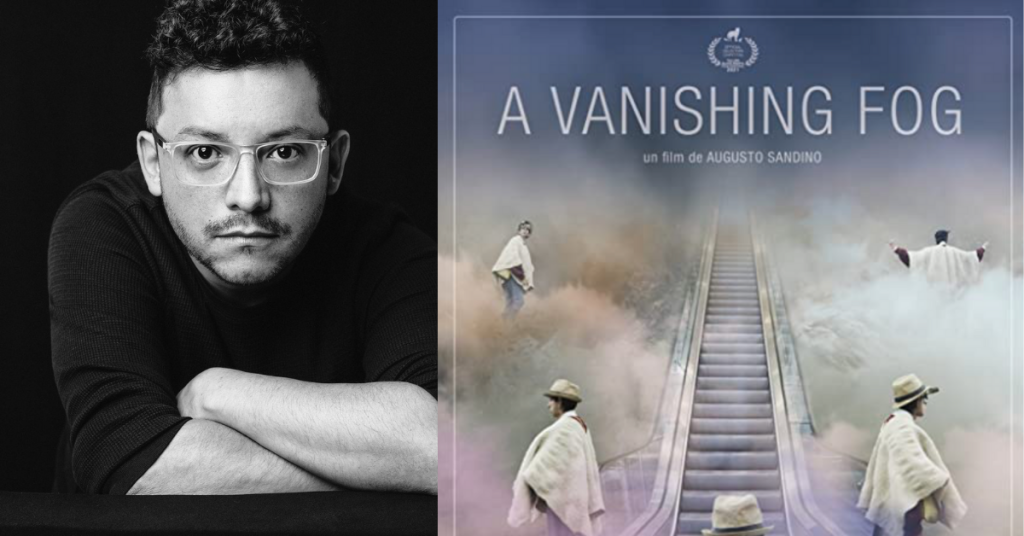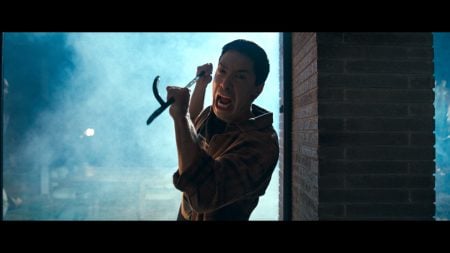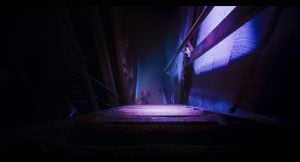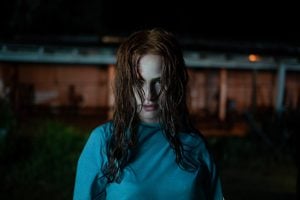A Vanishing Fog (2022) from Colombian director Augusto Sandino premieres at SXSW on March 11. The film focuses on F. (Sebastian Pii), a lonely man living in the isolated mountains with his father Colombo (Mario de Jesús Viana). F. watches over both the beautiful but fragile environment around him as well as his father, whose mind has almost fully left him behind. While bombs and gunfire throughout the mountain range gesture at a conflict raging in the background, F. makes his rounds, coming across an array of strange figures and bizarre circumstances. Fraught with experimental and surreal flourishes, A Vanishing Fog offers a meditative consideration of the human connection with our world and the violence that we enact upon it as well as one another.
I had the chance to sit down with Sandino to discuss his film, thoughts on environmentalism, and his particular view on what cinema should accomplish. The following is that conversation, edited lightly for length and clarity.

Devin: Right away, I want to ask about the setting. It is so central to all of the aesthetics and storytelling in A Vanishing Fog. Can you walk me through how you conceived of and settled on the Páramo of Sumapaz for this film?
Augusto: I knew beforehand that I wanted the film to unfold in a very isolated area, in a very specific setting of immense beauty. I picked this place because it’s just, it seems like it’s out of this planet. I see the setting as a character, you know. It is also the driving force for F. It’s his motivation, his reason of existence. It is also, well, I wanted to pick a place that encapsulated many of the beauties and the tragedies that have happened in Colombia throughout the 20th and 21st centuries. As I started researching this place, its people, and all the historical facts, I came to realize that I needed to speak about these issues, one way or another, using cinematic language.
I don’t speak directly about the tragedies and the horrendous things that have happened there throughout history, but it’s all in the framework of this present tense without a specific timeframe. I wanted to play with the notion of time. So even though I don’t speak to many of these explicitly, the setting gives me both a beautiful place to carry out the film, but also a way to have it develop and study the character and many different nuances, dimensions, in both the place and F.
In that sense, it was important to me that F. could appreciate the paradise around him, but also know that he might have to leave it behind. I wanted the audience to relate to that potential loss one way or another. And the one way to do it was to bring the film there, to bring F. and the setting together in my imagination and on film.

Devin: Continuing with the idea of the issues baked into A Vanishing Fog, it struck me that climate change and Colombia’s colonized past stand out as major backdrops, even if you’re not explicitly invoking them. Were those issues some of the ones you had in mind?
Augusto: We started to shoot the film in 2017, and then we carried out further expeditions in 2018. It was a difficult, very difficult, shoot. We had to design the whole production around the possibilities we had. And so, over that time, many things started happening, or continued happening and got worse. Many social and environmental leaders have been and were continuing to be killed. Assassinated by dark forces that nobody really knows who they are, although we can sort of guess where it comes from.
Colombia is a very wealthy country in natural resources and minerals, and that motivates a lot of this terrible behavior. It was really disturbing to see that my fiction, my imagination, which I thought going to an extreme, started revealing something that was really possible and that was already happening. So, in that case, the film does convey many themes and matters that concern what you asked about. However, this thing does not have a political agenda. It does not speak directly about anything or about anybody. But if the viewer can really, you know, grasp a little bit, I tried to get at things that go on everywhere. In Turkey, Ukraine, Afghanistan, Brazil, so on.
Coming back specifically to the film, the Páramo of Sumapaz is a huge natural water factory that is interconnected with the Amazon rainforest. It’s crucial for the ecological balance of the entire Western Hemisphere. We may not always think of these things, but everything concerning water is connected. The Mississippi River and the Amazon River, it’s all part of our global ecosystem. In that sense, the film does speak about colonization, climate change, the merciless exploitation of natural resources, and the forced displacement of people. These are issues we’ve had to deal with since the Spaniards came to the Americas. It’s all part of my using cinema to play with time and history through the political and environmental contexts.
Devin: Yeah. You’re focused on using the unfortunate timelessness to zero in on the human and environmental costs.
Augusto: For sure.
Devin: Thinking about all of that, I’m brought to Sebastian Pii’s role as F. He’s the lynchpin of the circumstances that lead to your aesthetic and thematic choices. How did you work with him to sculpt his performance to fit into your cinematic vision?

Augusto: He was my main concern going into the film. He is not an actor. He was a young student studying photography and I met him when he was back in school. I decided that he was ideal for this film because I could shape the film around him. I could work with him to find this character that was still very blurry in my mind. Because it’s not a film with much dialogue or many interactions between people. It’s more of a film that happens in your head. So what I’m presenting here is an experience through a character that I want to be incredibly empathetic.
Sebastian just has a way of raising curiosity. I wanted to explore his other dimensions, as a human being spiritually, emotionally, sexually, and physically. Take that to a limit in every sense, because I think the film is actually talking about loneliness. Solitude. t’s talking about. It’s funny because people say, Oh, that what is the film about? It is about a farewell to the Father. It’s a farewell to a land. But also that’s not what it’s about. It’s about looking, looking beyond what you see, and connecting, understanding, and stopping to see things in a superficial way.
So the biggest challenge, going back to your question, was to have the spectator see beyond F.’s physicality. To make him a sweet, tender, beautiful, loving character that people can see in all these ways I talked about. Sebastian and I had endless conversations about that, and we became really dear friends. It took two years to develop both that friendship and his character. One day he just came on and said he trusted me and gave over to the process. At one point, and I find this very amusing, he came to me and said “Gusto, you don’t really direct me.” And I said “Of course not. I don’t really want you to be an actor.” What I meant, and what he came to understand about the process, was that I wanted him to follow the character wherever it led him once the camera was rolling.
Devin: One of the results of that, from the audience perspective, is that the separation between F. and the landscape, all of the themes and explorations of self you speak to, meld and merge together. Both on visual and metaphorical levels. How did you look to achieve that in the day-to-day filming once you had these parameters set up?
Augusto: The thing is, the film revealed to me right then and there. Of course, there was a script. Of course, there was a storyboard and all these things, but we weren’t tied down to that I wanted to explore cinematic language as possibilities that come right then when you are there, with the camera set up and the actor ready. I mean, the way you breathe up there, the way you walk, the cold, the humidity, the elevation. Very high. It’s huge. It’s hard to breathe and carry equipment around. It was all about walking around. When the performers come to play their parts, they were just like “Oh my god, this is so crazy that this exists! It’s so isolated and so beautiful!” Nobody ever really comes here, so the setting is a trigger to our own imagination.
So it was a lot about taking advantage of whatever this beautiful place offered us. Looking to the color, to the texture, and using what I think was like 85% to 90% natural lighting. I really wanted to link it to the environment as much as possible.
Devin: Sticking with the interplay between what the environment gave you and what you had mapped out, you establish a real blend between dreamy realism and surreal flourishes. Did you go in with a hope to tilt one way or the other? Or did you find that interplay once you were on the shoot?

Augusto: When I started writing the film, it was just a collection on paper of the images that came to me. Very early on, one of them was the image of F. finding this escalator in the middle of nowhere among the trees. Which, actually, those trees grow one centimeter a year so the ones we were filming amidst were very very old. Anyway, the producers were very worried about how I was going to handle an escalator on the mountain. But we figured it out, and that is to say that some of the surreal ideas were on paper before we started, but I wasn’t going in saying to myself “Gusto, you’re going to make a surreal short. We must have this many surreal shots.”
But, Devin, when you’re up there, and you’re breathing at 12,000 feet above sea level. When you’re there by on your own, and you’re walking, and you’re walking nowhere, your ears start to perceive every little noise. Your breathing is sensitive. You know, like all your senses start to come out a shell and all of a sudden they’re so perfect. You’re breathing this air, and seeing these magnificent mountains and the nature around them. I think the surreal is a consequence of this beautiful place. It takes you to a different side of the human experience.
It is something like meditation when you sit down to watch A Vanishing Fog, reaching that feeling we had when we were up in the mountains flowing with the experience. You have to allow yourself to get sucked in by the images and sounds, and sort of travel to this time and place. My idea was not “Let’s make it weird!” No, these images to me are so natural. I was making a film within the logic of the [setting and character]. The camera movements and framings are very organic.
And this is the big challenge of making films. It’s very easy to get lost and to forget about your initial concept as you’re chasing the feel. But I was lucky on A Vanishing Fog to have people committed to that concept with me. We stayed loyal to it.
Devin: You most certainly did, because everything you talk about came through for this viewer.
Augusto: Oh, thank you, so glad to hear that! It is the beauty of the cinematic language that you can feel those ideas by watching something I made so far away from where you are. It is a wonderful, beautiful thing.

Devin McGrath-Conwell holds a B.A. in Film / English from Middlebury College and is currently pursuing an MFA in Screenwriting from Emerson College. His obsessions include all things horror, David Lynch, the darkest of satires, and Billy Joel. Devin’s writing has also appeared in publications such as Filmhounds Magazine, Film Cred, Horror Homeroom, and Cinema Scholars.





![‘Anemone’ Review – Ronan Day-Lewis’ Debut Feature Is A Bold Visual Feast Anchored By Daniel Day-Lewis’ Tremendous Return [NYFF 2025] ‘Anemone’ Review – Ronan Day-Lewis’ Debut Feature Is A Bold Visual Feast Anchored By Daniel Day-Lewis’ Tremendous Return [NYFF 2025]](https://cdn.geekvibesnation.com/wp-media-folder-geek-vibes-nation/wp-content/uploads/2025/09/Anemone-Still-300x126.jpg)
